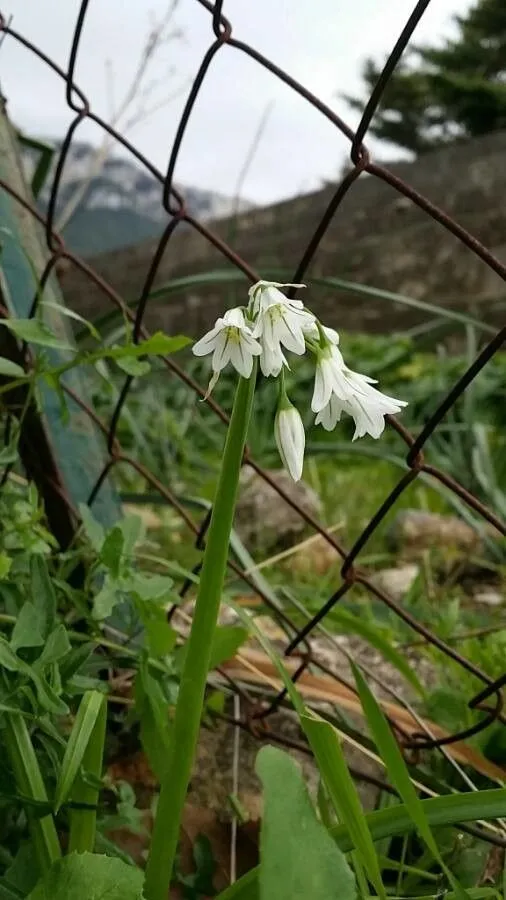
Author: L.
Bibliography: Sp. Pl.: 300 (1753)
Year: 1753
Status: accepted
Rank: species
Genus: Allium
Vegetable: Unknown
Observations: W. & C. Medit.
Triquetrous garlic, scientifically known as Allium triquetrum, is a notable member of the Amaryllidaceae family. This perennial herb is distinguished by its triangular stem, which is a unique feature lending to its common name. Native to the western and central Mediterranean regions, Triquetrous garlic thrives in temperate climates and can often be found flourishing along shaded forest floors, streams, and moist environments.
The plant blooms primarily in the spring, revealing delicate, bell-shaped flowers. These flowers, which are white with green veining, dangle gracefully in a drooping manner, adding a touch of elegance to the natural landscapes where they grow. The blossoms are also known for their slight, gentle fragrance, making them an attractive option for garden enthusiasts seeking subtle beauty.
In addition to their ornamental value, Triquetrous garlic plants are also appreciated for their culinary uses. The leaves, bulbs, and flowers exude a mild garlic aroma and taste, which makes them suitable for various culinary dishes. They can be chopped and added to salads, soups, or as an aromatic garnish, providing both flavor and visual appeal.
This species was first documented in 1753 by the renowned botanist Carl Linnaeus, whose extensive work in taxonomy significantly contributed to the classification of many plant species. Linnaeus’s description and categorization of Allium triquetrum can be found in his seminal publication “Species Plantarum.”
Overall, Triquetrous garlic is not only a charming addition to natural and cultivated environments but also a versatile plant with practical uses. Its unique structure and pleasant aroma make it a favorite among botanists, gardeners, and culinary enthusiasts alike.
Eng: three-cornered garlic, threecorner leek, angled onion, three-corner garlic, three-corner leek, triquetrous garlic, triquetrous leek, onion weed, three-cornered leek
Deu: dreikantiger lauch
Swe: sloklök
Nld: driekantig look
Cym: cenhinen drichornel, garlleg trionglog
En: Triquetrous garlic, Triquetrous leek, Angled onion, Three-corner garlic, Three-corner leek, Threecorner leek, Three corner Garlic, Three-cornered Leek, Three-cornered Garlic, Onion weed, Triangular-stalked Garlic
Ar: ثوم مثلث
Ca: Allassa blanca, Allassa, Vitrac
Kw: Kennin trihornek
Co: Sambula
Cs: Česnek trojrohý
Nl: Driekantig look, Driekantige Look
Fi: Iberianlaukka
Fr: Ail à trois angles, Ail à tige triquètre, Ail campanulé
De: Dreikantiger Lauch, Glöckchen-Lauch
It: Aglio triquetro, Agilo Selvatico, Porro Selvatico
Ru: Лук трёхгранный
Sc: Appara
Es: Lagrimas de la virgen, Lágrimas de la Virgen
Sv: Sloklök
Cy: Garlleg trionglog, Cenhinen Drichornel
Taken May 13, 2018 by Michel Morize (cc-by-sa)
Taken May 13, 2018 by Michel Morize (cc-by-sa)
Taken Apr 15, 2017 by aymeric (cc-by-sa)
Taken Apr 17, 2018 by Pierre-Henri Galavielle (cc-by-sa)
Taken Mar 4, 2018 by Acoto Grande (cc-by-sa)
Taken Mar 27, 2022 by Pierre LEON (cc-by-sa)
Taken Apr 17, 2022 by JYCO (cc-by-sa)
Taken Mar 21, 2022 by Sylvain Piry (cc-by-sa)
Taken Mar 1, 2022 by Pierre LEON (cc-by-sa)
Taken Feb 8, 2022 by Pierre LEON (cc-by-sa)
Taken Mar 8, 2021 by Florent Beck (cc-by-sa)
Taken Mar 8, 2021 by Florent Beck (cc-by-sa)
Taken May 5, 2022 by David Hocken (cc-by-sa)
Taken Apr 9, 2017 by Gioia (cc-by-sa)
Taken Feb 8, 2022 by Pierre LEON (cc-by-sa)
Taken Mar 21, 2022 by Sylvain Piry (cc-by-sa)
Taken Dec 21, 2021 by did_21 (cc-by-sa)
Taken May 19, 2013 by Henk Van Lottum (cc-by-sa)
Taken Mar 8, 2021 by Florent Beck (cc-by-sa)
Taken Feb 8, 2022 by Pierre LEON (cc-by-sa)
Taken Jan 1, 1970 by Photoflora – L’Abbé COSTE (©)
Taken Mar 29, 2019 by Carole England (cc-by-sa)
Taken Mar 19, 2021 by Iwein LF (cc-by-sa)
Taken Apr 29, 2022 by Raffaello 2 Garofalo (cc-by-sa)
Taken Apr 12, 2021 by Dieter Wagner (cc-by-sa)
© copyright of the Board of Trustees of the Royal Botanic Gardens, Kew.
© copyright of the Board of Trustees of the Royal Botanic Gardens, Kew.
Taken Apr 16, 2020 by Jean Claude Grot (cc-by-sa)
Taken Mar 13, 2021 by Rita61 Rita61 (cc-by-sa)
Taken Jun 8, 2019 by samuel jean (cc-by-sa)
Taken May 3, 2019 by Cristiano Francesco (cc-by-sa)
Taken Jun 13, 2022 by Chuck bailey (cc-by-sa)
Family: Myrtaceae Author: (F.Muell.) K.D.Hill & L.A.S.Johnson Bibliography: Telopea 6: 402 (1995) Year: 1995 Status:…
Family: Rubiaceae Author: Pierre ex A.Froehner Bibliography: Notizbl. Bot. Gart. Berlin-Dahlem 1: 237 (1897) Year:…
Family: Sapindaceae Author: Koidz. Bibliography: J. Coll. Sci. Imp. Univ. Tokyo 32(1): 38 (1911) Year:…
Family: Asteraceae Author: A.Gray Bibliography: Pacif. Railr. Rep.: 107 (1857) Year: 1857 Status: accepted Rank:…
Family: Fabaceae Author: Medik. Bibliography: Vorles. Churpfälz. Phys.-Ökon. Ges. 2: 398 (1787) Year: 1787 Status:…
Family: Aspleniaceae Author: (Cav.) Alston Bibliography: Bull. Misc. Inform. Kew 1932: 309 (1932) Year: 1932…